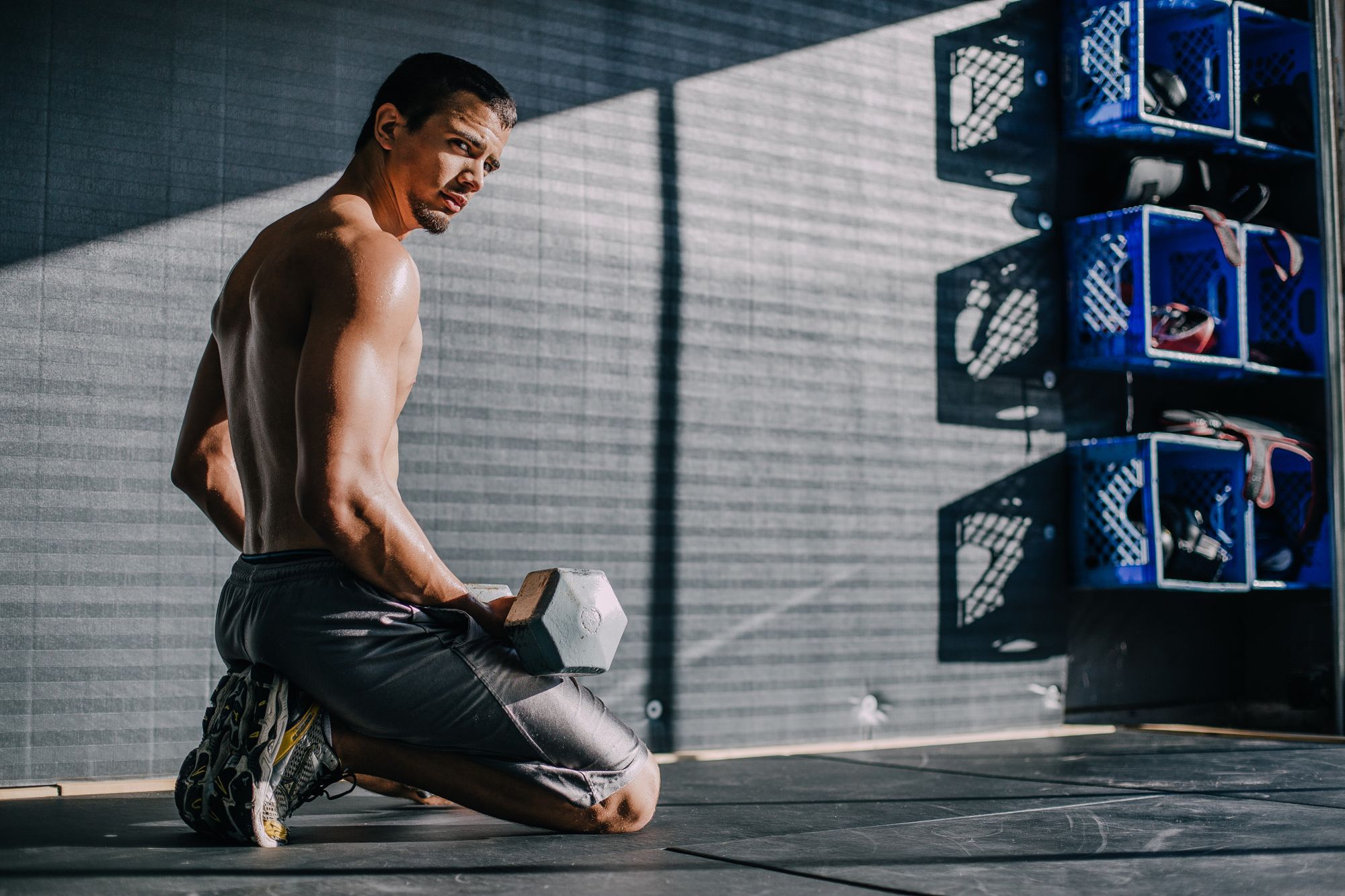3 Things to Do During Any Workout Session to Maximize Muscle Growth
We all want to make the most of our gym sessions. Here are 3 things you must do in any workout session to maximize your muscle growth results.

We all want to make the most of our gym sessions.
After all, we’re already physically there—so how can we make every second a muscle-growth-inducing one?
Barring shooting yourself up with steroids, there are 3 things you could do during any workout session that’ll seriously boost your muscle-building efforts 💉❌
In this article, we cover:
- What they are
- How you could implement them into your workout routine AND
- One bonus tip on how you could build muscle fast (almost effortlessly)
#1: Always do the heavy work first
In general, exercises in the gym fall under two categories: 1) compound exercises and 2) isolation exercises.
Compound exercises are any moves that work multiple muscle groups simultaneously. Examples include the squat (find out how to determine the best squat stance for you here), bench press, overhead press, and deadlift.
On the other hand, isolation exercises target a specific muscle group and involve the movement of a single joint. The calf raise, bicep curl, triceps pushdown, and dumbbell fly are all examples of isolation exercises.
Compound exercises aren't necessarily better than isolation exercises at stimulating muscle growth.
Research has consistently shown that multi-joint (i.e., compound) and single-joint (i.e., isolation) exercises are equally effective at building muscle strength and size.
However, each has its own drawbacks:
💪 Isolation exercises: Sure, you can target nearly all muscle groups—probably even the ones you've never heard of—but running through them all will take so. much. time.
What does this mean, then?
Easy: this means you should always do a mix of compound and isolation exercises in any workout session. Beyond that, it’s also important to note that the order matters.
Do your compound movements first.
With the amount of weight you can push, you’re likely to accumulate way more fatigue (both CNS and physical) on compound movements. So you want to ensure you're as fresh as possible on those sets. The better you can push, the higher your training volume, and the more muscle growth you’ll experience.
But wait. Does it not matter that you'll be tired when performing isolation exercises? Not really. That’s because isolation exercises carry less injury risk than compound ones. So long as you’re still able to complete your sets with relatively good form, you’ll be just fine.
Still, less injury risk doesn’t mean zero injury risk. So, you might wish to check out the following article … well, just in case:

#2: Don’t rush your sets
One set of Bulgarian split squats—done. Then, after a mere 15 seconds, with your heart still feeling like it's beating out of your throat, you go in for a second set.
While you may think this maximizes your time in the gym (pfft … who needs rest? I’m fit AF.), nothing could be further from the truth.
Time and again, research shows that longer rest times in between sets lead to better muscle growth.
Yes, no matter what those pump-chasing bros say.
In a 2016 randomized controlled trial published in the Journal of Strength and Conditioning Research, for example, researchers randomly divided participants into 2 groups:
- Group 1: Performed a resistance program with 1-minute rest intervals (SHORT)
- Group 2: Performed the same resistance program with 3-minute rest intervals (LONG)
After 8 weeks, the researchers found that those in group 2 (i.e., LONG) experienced greater lower body muscle growth and strength than those in group 1 (i.e., SHORT).
That's not the only study supporting the importance of more extended resting periods for muscle growth.
At least 5 other scientific studies, including a more recent 2021 one published in the International Journal of Exercise Science, agree. Those interested in further reading can check out this list of research here:
- Effect of Rest Interval Duration on the Volume Completed During a High-Intensity Bench Press Exercise
- Influence of Different Rest Interval Length in Multi-Joint and Single-Joint Exercises on Repetition Performance, Perceived Exertion, and Blood Lactate
- A comparison of 3 different rest intervals on the exercise volume completed during a workout
- Effects of rest interval length on Smith machine bench press performance and perceived exertion in trained men
Why do longer resting periods lead to better muscle growth, though?
Ultimately, allowing yourself adequate rest between sets will enable you to maintain training loads better from set to set (who would have known?), thereby enabling more volume when sets are equated between short and long rest training.
Bottom line? Please, please give yourself enough time to catch your breath between sets.
#3: Don’t do too much
Hmm. So, if more training volume = better muscle growth, you should cram as many sets as possible into your workout (with adequate rest in between, of course—because now, you know better) … right?
No. As it turns out, there is an upper limit to the number of sets per muscle group you can do in a single workout before it starts to do more harm than good.
Anything you do beyond those number of sets will be junk volume.
What are the exact numbers, though? According to a recent 2022 meta-analysis published in the Journal of Human Kinetics, it’s a range: 12 to 20 weekly sets per muscle group per week. That means if you train …
- 3 times weekly: Do no more than 4 to 6 sets per workout
- 4 times weekly: Do no more than 3 to 5 sets per workout
- 5 times weekly: Do no more than 2 to 4 sets per workout
Of course, note that these are general recommendations. Your exact "upper limit" may vary depending on your lifting experience, biological sex, and unique physiological characteristics.
We dive deeper into this topic here:

If you’re looking to maximize your muscle growth, a lot of it comes down to your workout program
Exercise order, inter-set rest periods, and the number of sets you should do in a workout session—these all tie back to your workout programming.
And beyond simply caring about what you do during a workout session, the truth is, if you’re looking to maximize your muscle growth results, you’ll also need to account for the broader picture of workout programming.
That includes specific exercise selections, training frequency, and load management (i.e., periodization).
Feeling lost? Overwhelmed? Confused?
Well, what if you could swap these negative emotions for confidence? Confidence that you're training exactly how you need to achieve your fitness goals?
No, it’s not too good to be true. Because there’s GymStreak: the AI-powered personal trainer app that’ll take care of workout programming—and tailor your routine to your specific needs, no matter how they may change over weeks, months, or years.
Here's a sneak peek:
Expert, Done-For-You Workout Plans Are a Click Away
(Finally) train with confidence. Just download the app, and you're all set.
References
Baz-Valle, E., Balsalobre-Fernández, C., Alix-Fages, C., & Santos-Concejero, J. (2022). A Systematic Review of The Effects of Different Resistance Training Volumes on Muscle Hypertrophy. Journal of Human Kinetics, 81, 199–210. https://doi.org/10.2478/hukin-2022-0017
Gentil, P., Soares, S., & Bottaro, M. (2015). Single vs. Multi-Joint Resistance Exercises: Effects on Muscle Strength and Hypertrophy. Asian Journal of Sports Medicine, 6(2), e24057. https://doi.org/10.5812/asjsm.24057
Hernandez, D. J., Healy, S., Giacomini, M. L., & Kwon, Y. S. (2021). Effect of Rest Interval Duration on the Volume Completed During a High-Intensity Bench Press Exercise. Journal of Strength and Conditioning Research, 35(11), 2981–2987. https://doi.org/10.1519/JSC.0000000000003477
Millender, D. J., Mang, Z. A., Beam, J. R., Realzola, R. A., & Kravitz, L. (2021). The Effect of Rest Interval Length on Upper and Lower Body Exercises in Resistance-Trained Females. International Journal of Exercise Science, 14(7), 1178–1191.
Schoenfeld, B. J., Ogborn, D., & Krieger, J. W. (2017). Dose-response relationship between weekly resistance training volume and increases in muscle mass: A systematic review and meta-analysis. Journal of Sports Sciences, 35(11), 1073–1082. https://doi.org/10.1080/02640414.2016.1210197
Schoenfeld, B. J., Pope, Z. K., Benik, F. M., Hester, G. M., Sellers, J., Nooner, J. L., Schnaiter, J. A., Bond-Williams, K. E., Carter, A. S., Ross, C. L., Just, B. L., Henselmans, M., & Krieger, J. W. (2016). Longer Interset Rest Periods Enhance Muscle Strength and Hypertrophy in Resistance-Trained Men. Journal of Strength and Conditioning Research, 30(7), 1805–1812. https://doi.org/10.1519/JSC.0000000000001272
Senna, G., Figueiredo, T., Scudese, E., Baffi, M., Carneiro, F., Moraes, E., Miranda, H., & Simão, R. (2012). Influence of Different Rest Interval Length in Multi-Joint and Single-Joint Exercises on Repetition Performance, Perceived Exertion, and Blood Lactate. Journal of Exercise Physiology Online, 15, 96–106.
Tibana, R. A., Vieira, D. C. L., Tajra, V., Bottaro, M., de Salles, B. F., Willardson, J. M., & Prestes, J. (2013). Effects of rest interval length on Smith machine bench press performance and perceived exertion in trained men. Perceptual and Motor Skills, 117(3), 682–695. https://doi.org/10.2466/06.30.PMS.117x27z2
Willardson, J. M., & Burkett, L. N. (2005). A comparison of 3 different rest intervals on the exercise volume completed during a workout. Journal of Strength and Conditioning Research, 19(1), 23–26. https://doi.org/10.1519/R-13853.1


